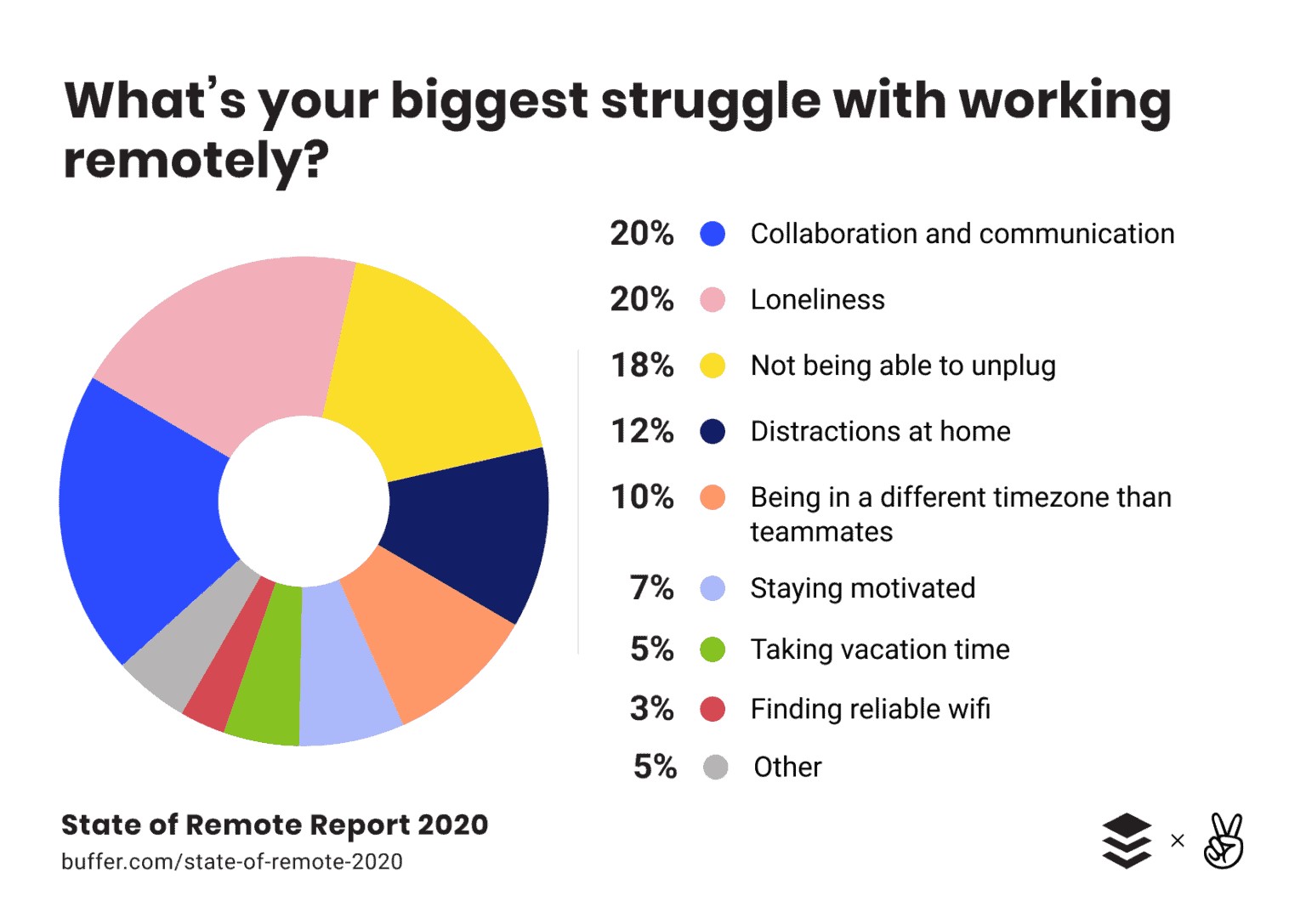The COVID-19 pandemic has thrust remote work into the limelight, but the concept isn’t new or ground-breaking. Even before the pandemic, around 4.7 million U.S. employees (or 3.4% of the U.S. workforce) were working remotely, according to the U.S. Census Bureau and the Bureau of Labor Statistics.

Also called telework, remote work is an attractive work option for both employers and employees. Companies find cost savings because of the reduced need for office infrastructure and widen the talent pool because hires are no longer geographically restricted. Studies have shown that remote work leads to greater productivity, higher retention, and better performance.
Although employers have woken up to the benefits of remote work, it is not without some challenges. Remote work isn’t just about videoconferencing and email. The culture of a remote-first company revolves around transparency, trust, communication, and accountability. Remote workers need to feel as if they are a part of the core team rather than like they’re working off on their own.
Thus, leading a remote team is quite different from leading an in-office team.
Leading Remote Teams: Challenges and Solutions.
Various challenges abound for managers and leaders of remote teams, especially those who find themselves separated from their reports for the first time. The lack of face-to-face supervision, the distractions at home in the absence of a dedicated workspace, and the potential for information to slip through the cracks can derail the morale and performance of a remote team.
Below are six best practices followed by industry leaders to effectively manage remote teams:
- Clear and open communication
The State of Remote Work 2020 report reveals that the biggest struggles for remote employees are communication and collaboration (20%) and loneliness (20%), followed by “not being able to unplug (18%).”
 Collaboration in a remote team is tough because it may be difficult to call ad hoc meetings to discuss an idea. Team members cannot gather information by passive means like observing each other, chatting near the water cooler, picking up on body language cues, or chatting over lunch. This can cause feelings of isolation and demotivation.
Collaboration in a remote team is tough because it may be difficult to call ad hoc meetings to discuss an idea. Team members cannot gather information by passive means like observing each other, chatting near the water cooler, picking up on body language cues, or chatting over lunch. This can cause feelings of isolation and demotivation.Leaders must set expectations about which communication channels to use for various types of information. For instance:
- Public chat channels on apps like Slack and Tandem may be used to keep team members informed of important conversations and decisions.
- Using shared documents instead of emails can help prevent team members from missing out on important information.
- Writing everything down and sharing documents keeps everyone on the same page. Takeaways from important meetings and conversations should be shared with all team members.
Remote employees are usually at a disadvantage during brainstorming meetings because they’re left out of side conversations and may face technological challenges. Companies can use digital whiteboarding and brainstorming tools like Miro, Mural, or Google Docs to collaborate effectively.
Leaders must create communication redundancy to ensure that everyone understands their message. Using multiple channels of communication (phone calls, emails, video calls, text messages, chat channels) to share the same message helps eliminate confusion. For instance, if you discussed something on the phone, summarize the key points of the conversation in an email and ask the recipient to confirm his/her understanding.
- Setting accountability
It’s understandable when managers, who have been separated from their team members for the first time, feel like they’re losing control. However, steps like dictating response times and working hours, setting challenging targets, or micromanaging will not help keep the team accountable. Leaders should focus on work output rather than time-in-seat.How can they do this?
First, leaders should allow their employees autonomy to complete tasks in their own way. This builds confidence and keeps people motivated to perform well. Communicate productivity and performance standards clearly so that everyone knows what is expected of them. Then trust them to do their work well!
Managers can follow up with team members via phone calls or video calls to check the progress of their tasks and discuss any challenges. Meetings shouldn’t just be about productivity; they should be used to build trust and foster connections.
The success of remote teams depends on trust and transparency between team members. Leaders should work on creating a rapport with their employees by getting to know them outside of work.
Remote team building activities, such as virtual watercooler channels, virtual icebreaker games, or virtual house tours can help overcome social isolation and allow team members to bond with each other.
- Meetings – agenda-driven, frequent, scheduled
Remote work necessitates scheduling more meetings to catch up with each other and discuss projects. However, the flip side is meeting fatigue, which drains people.Leaders should ensure that each meeting has an agenda that has been circulated among attendees beforehand. People will thus be prepared for the meeting, saving time and making it more effective. Action points and takeaways from the meeting should be documented.
Regular and frequent one-on-one meetings are important in a remote setting for leaders to connect with their employees on a more personal level. Managers and their reports can discuss matters that they would not talk about at group meetings, such as career development or issues with a coworker.
Daily standup meetings, especially via video call, are helpful to ensure that team members are aware of what their coworkers are doing and their manager’s expectations of them. Video ensures that non-verbal cues, which make up much of our language, are not missed, which helps prevent misunderstanding, confusion, and conflict.
- Open mindedness/flexibility
Remote managers will do well to remember that 70% of an employee’s engagement is driven by their manager. Thus, to keep motivation and performance levels high, managers must individualize their management style to each employee to best support them.Managers should endeavor to keep an open mind about things that may or may not work in a remote setting. They need to be open to experiment with different ways of working to maximize performance.
- Equipping employees with tools to perform
Even the most tech-savvy employee may face technical difficulties while working from home. Leaders should be prepared to support remote workers by equipping them with the right tools and resources to work from anywhere at any time. Technology support teams should be available to help people tackle problems.While there are tons of apps and platforms to aid remote work, it is important to choose the ones that offer security of sensitive data and ensure privacy of workers. Popular remote work tools like Microsoft Office Teams, Trello, Zoom, Google Suite, and Slack have made communication, collaboration, and project management easy.
- Training and career development
The physical separation between trainers and learners working remotely cannot be bridged simply with PowerPoint slides and video conferencing. Certain steps can be taken to deliver a proper remote training session:
a) Select a delivery model (synchronous learning/asynchronous learning/blended learning) to maximize effectiveness.
b) Use the proper tools, like LMS platforms, authoring tools, conferencing platforms, or dedicated virtual training platforms.
c) Prepare learning materials to suit the delivery model chosen, such as videos or presentations.
d) Deliver the training module using the chosen tools.
e) Track learning results. This important step will help you measure the effectiveness of your training.
Conclusion
It’s clear that leading remotely is complicated. A combination of trust, autonomy, and frequent check-ins should help build a robust remote work culture in any organization.
Even after the COVID-19 pandemic ends, the lessons learned and insights gained from the experience should help leaders develop a stronger connection with their employees.
In fact, the “world’s largest WFH experiment” appears to have been so successful that some employees, especially knowledge workers, may never go back to working in an office full time.



